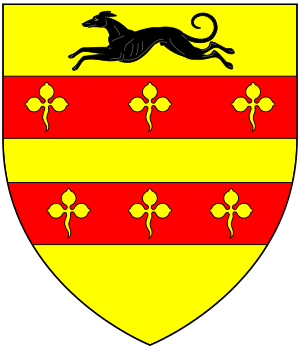Thomas Palmer (died 1553) facts for kids
Sir Thomas Palmer (died 1553) was an English soldier and a person who worked closely with the King and Queen, known as a courtier. He played a big part in the downfall of Edward Seymour, 1st Duke of Somerset in 1551–1552. Sadly, Sir Thomas Palmer was executed in 1553 because he supported Lady Jane Grey during a time when people were arguing over who should be the next ruler of England.
Contents
Sir Thomas Palmer's Life and Career
Sir Thomas Palmer was the youngest of three sons. His father was Sir Edward Palmer. His mother was the sister of Sir Richard Clement from Ightham Mote, Kent.
Early Years at Court
Thomas Palmer started working at the royal court when he was young. In 1515, he was serving in Tournai, a city in France. By 1517, he was involved in managing lands for the honour of Richmond. In the same year, he became a bailiff in Barton-upon-Humber, Lincolnshire.
He worked as a special attendant, called a gentleman-usher, for King Henry VIII in 1519. He was also present at the famous Field of the Cloth of Gold meeting in 1520. He gained more important roles, like overseeing customs and trade in 1519. In 1521, he became a surveyor for the lordship of Henley-in-Arden.
Military Service and Knighthood
Sir Thomas Palmer served in a military campaign in 1523. That same year, he was given the manor of Pollicot, Buckinghamshire. He also received land in London.
On November 10, 1532, he was made a knight in Calais, France. He became the captain of Newenham Bridge there. King Henry VIII liked him and even played dice with him. In 1533, he became the knight-porter of Calais.
He was captured by the French during a trip from Guisnes. He had to pay money to be set free, which was called a ransom. He wrote to Thomas Cromwell in 1534 about his services and this capture. In 1535, he helped collect taxes in Calais. Palmer was also involved in the event at the Bridge of Arde in 1540.
In July 1543, while he was the treasurer of Guisnes, he joined a military force against the French. In August 1545, William Grey, 13th Baron Grey de Wilton sent him as a messenger to the King. Around this time, he was captain of a fort called the 'Old Man' at Boulogne. By the time King Henry VIII died, Palmer was known for his bravery.
Wars with Scotland: The Rough Wooing
After King Henry VIII died, Edward VI of England became king. His protector, Protector Somerset, became an enemy of Palmer. Palmer was sent to the border with Scotland to fight in a war called the Rough Wooing. This was a time when England tried to force Scotland to agree to a marriage between Edward VI and Mary, Queen of Scots.
In January 1548, Palmer and an Italian engineer named "Master John" planned to make the forts stronger at Broughty Castle near Dundee. Palmer told his commander, Grey of Wilton, that the ground was too rocky to dig.
In 1548, Palmer bravely brought supplies into Haddington several times during a siege. King Edward VI heard about his brave actions. The King even mentioned Palmer and Thomas Holcroft in his personal journal. Palmer also kept his jobs in Calais. In June 1550, he was sent with Sir Richard Lee to check and repair forts on the Scottish border.
Political Changes and Lady Jane Grey
On October 7, 1551, Palmer was the first person to reveal that Somerset was planning against the King. He told this to the Earl of Warwick, who later became John Dudley, 1st Duke of Northumberland. Palmer hoped to gain power with Warwick. He had received land from monasteries and was building a house in the Strand.
On February 18, 1552, Palmer received a pardon for any past wrongdoings. This cleared him from being suspected as a supporter of Somerset. On March 3, he was appointed to a group that would divide disputed land on the borders.
However, Palmer supported Lady Jane Grey when she briefly became queen. When Northumberland lost power, Palmer was in trouble. He was sent to the Tower of London on July 25, 1553. He was found guilty on August 19, 1553.
During his trial, Palmer was the only one to speak up. He shouted that the judges themselves had been part of Lady Jane's council. He said they deserved as much punishment as him and that the trial was unfair.
Sir Thomas Palmer was executed on August 22, 1553, along with Sir John Gates and the Duke of Northumberland. Before his execution, he attended a religious service. When he stood on the platform for his execution, he gave a speech saying he was dying as a Protestant.
Sir Thomas Palmer's Family
Sir Thomas had two older brothers. The first, Sir John, was known as 'Buskin Palmer' or 'Long Palmer'. He served as sheriff for Surrey and Sussex in 1533 and 1543. Sir John died in 1563.
His second brother was Sir Henry Palmer (died 1559) from Wingham in Kent. Sir Henry married Jane, who was the daughter of Sir Richard Windebank. They had three sons: Sir Thomas Palmer 'the Traveller,' Arnold, and Edward.
See also


